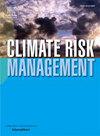Enriching the European Shared Socio-economic Pathways with considerations of biodiversity and nature using a nexus approach
IF 5
2区 环境科学与生态学
Q1 ENVIRONMENTAL SCIENCES
引用次数: 0
Abstract
The global climate and biodiversity crises are deeply interconnected, yet current research and policy frameworks often treat them in isolation. The widely used Shared Socio-economic Pathways (SSPs), which underpin climate change assessments and guide policy, exemplify this gap: they neglect biodiversity and nature, overlooking critical feedbacks between socio-economic and environmental systems. This omission constrains options for addressing both crises simultaneously and obscures cascading risks. We address this gap through a co-creation process at the European scale, enriching the European-SSPs with considerations of biodiversity and nature using a nexus approach (spanning biodiversity, energy, food, health, water, and transport). We compare the original and enriched narratives through a systems analysis, revealing a substantial increase in system complexity that shifts the relative significance of indirect drivers across SSPs due to novel feedbacks with biodiversity and other sectors. For example, across several scenarios economic and technological development reinforce unsustainable resource extraction, even if partially oriented toward sustainability. In contrast, governance, environmental respect and social cohesion prove critical to enabling positive outcomes for biodiversity but can also perpetuate biodiversity loss if not fully aligned with environmental goals. These findings highlight the need for adaptive approaches that respond to emergent socio-economic conditions and systemic policymaking that accompanies technical interventions with improvements in governance. They also demonstrate how ‘biodiversity-centric’ scenarios can strengthen the IPCC scenario framework by capturing critical feedbacks between biodiversity and socio-economic drivers of climate change, enabling more integrated research and policy.
利用联系方法丰富欧洲共享的社会经济路径,考虑生物多样性和自然
全球气候和生物多样性危机是密切相关的,但目前的研究和政策框架往往孤立地对待它们。广泛使用的支持气候变化评估和指导政策的共享社会经济路径(ssp)就是这种差距的例证:它们忽视了生物多样性和自然,忽视了社会经济和环境系统之间的关键反馈。这种遗漏限制了同时解决这两个危机的选择,并模糊了层叠风险。我们通过在欧洲范围内的共同创造过程来解决这一差距,利用联系方法(跨越生物多样性、能源、食品、健康、水和运输),在考虑生物多样性和自然的基础上丰富欧洲-可持续发展战略计划。我们通过系统分析比较了原始和丰富的叙述,揭示了由于生物多样性和其他部门的新反馈,系统复杂性的大幅增加改变了ssp之间间接驱动因素的相对重要性。例如,在若干情况下,经济和技术发展加强了不可持续的资源开采,即使部分面向可持续性。相比之下,治理、环境尊重和社会凝聚力对于实现生物多样性的积极成果至关重要,但如果不完全符合环境目标,也可能使生物多样性的丧失永久化。这些发现突出表明,需要采取适应方法,以应对紧急的社会经济状况和系统性决策,并在技术干预措施的同时改善治理。它们还展示了“以生物多样性为中心”的情景如何通过捕捉生物多样性和气候变化的社会经济驱动因素之间的关键反馈来加强IPCC情景框架,从而实现更综合的研究和政策。
本文章由计算机程序翻译,如有差异,请以英文原文为准。
求助全文
约1分钟内获得全文
求助全文
来源期刊

Climate Risk Management
Earth and Planetary Sciences-Atmospheric Science
CiteScore
8.20
自引率
4.50%
发文量
76
审稿时长
30 weeks
期刊介绍:
Climate Risk Management publishes original scientific contributions, state-of-the-art reviews and reports of practical experience on the use of knowledge and information regarding the consequences of climate variability and climate change in decision and policy making on climate change responses from the near- to long-term.
The concept of climate risk management refers to activities and methods that are used by individuals, organizations, and institutions to facilitate climate-resilient decision-making. Its objective is to promote sustainable development by maximizing the beneficial impacts of climate change responses and minimizing negative impacts across the full spectrum of geographies and sectors that are potentially affected by the changing climate.
 求助内容:
求助内容: 应助结果提醒方式:
应助结果提醒方式:


